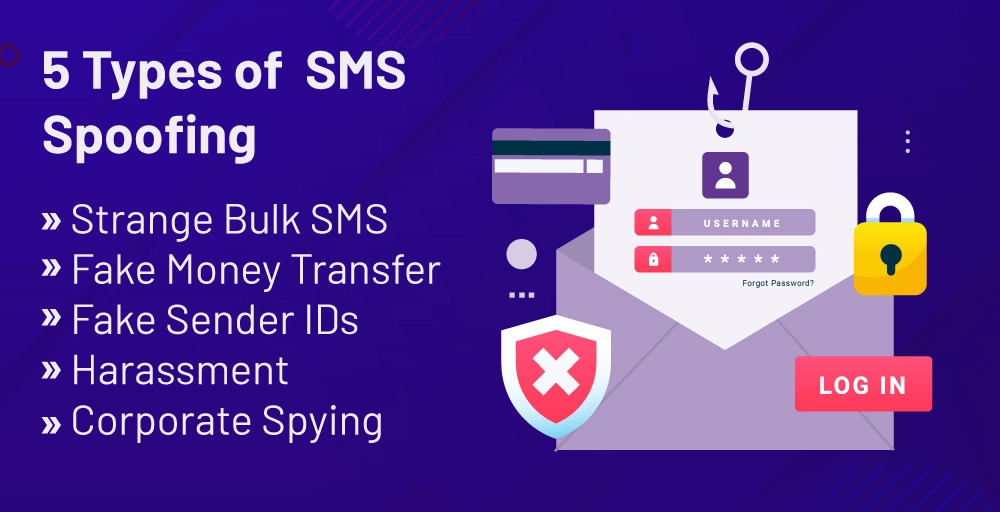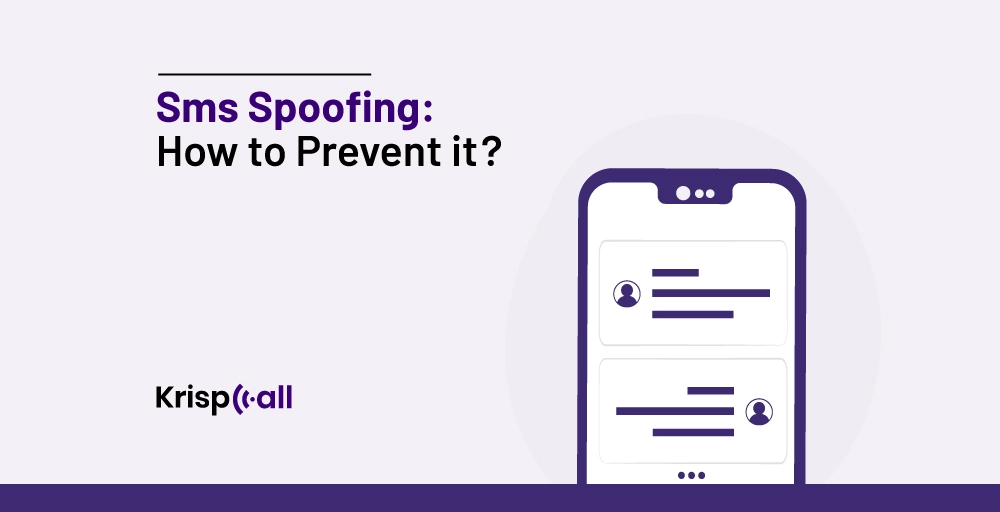Nowadays, scammers and their activities are growing daily. At the same time, it is getting harder😣 to spot scammers due to advancements in their methods.
Innocents don’t even realize if scammers are targeting them because it is impossible to tell whether the message is real or fake (SMS spoofing). Later, when they discover that their money has gone, it is too late😴 for them to comprehend everything.
Therefore, with this blog, we will explain SMS spoofing, how it works, its types, and how you can detect and prevent it. We will also discuss the differences between legal and illegal uses of SMS spoofing.
🔑KEY HIGHLIGHTS
- SMS spoofing is a technique for manipulating the sender details of a text message to make it seem as if the message came from a different source than the real one.
- Strange bulk SMS, fake money transfers, fake sender IDs, harassment, and corporate spying are the types of SMS spoofing.
- You can detect SMS spoofing by looking for suspicious sender names, emergencies, suspicious links, too-generous offers, and poor spelling or grammar in SMS.
- You can prevent SMS spoofing by blocking unknown numbers, avoiding suspicious links, enabling spam filters, analyzing sender IDs, and keeping the phone updated.
- Whistleblowers, dissidents, or businesses use SMS spoofing to hide identities, whereas scammers use SMS spoofing to exploit people’s trust in well-known organizations.
What Is SMS Spoofing?
SMS spoofing is a technique employed to modify the sender details of a text message to make it seem as if the text came from a different or legitimate source than it actually did.
Scammers mostly use this tactic to make it look like their text message comes from a different numb

Simply put, it is a text message💬 from fraud that uses a fake sender ID or number to trick a recipient into sharing personal details. For instance, if you get a text message from a random number saying you have won a prize and asking for bank details, you are chatting with an SMS spoof attacker. They replace the real sender ID with a fake one, appearing as your bank🏛️ or credit provider.
How Does SMS Spoofing Work?
SMS spoofing allows the sender of a text message to manipulate the real sender by replacing it with a fake one. This technique lets the sender be seen as someone else when the message goes to the receiver’s phone.
Therefore, the message arrives on the receiver’s phone📲 under a different name, phone number, or both, making it untraceable and unblockable. Many apps support✅ text spoofing since it is also done for valid purposes, such as banks displaying their name for branding. However, scammers are increasingly using text-spoofing apps to commit crimes.
Scammers generally choose trusted brands or public figures’ names and target🎯 people by sending an SMS with a fake ID. SMS spoofing includes spoofing emails, setting up spoofed websites, and using caller ID spoofs to continue their scams.
Types Of SMS Spoofing
There are various types of SMS spoofing with the intention to deceive innocent or take revenge. Some of the main types of SMS spoofing are as follows:

1. Strange Bulk SMS
When you receive unasked messages in bulk, that can probably be one type of text messaging spoofing. This technique includes sending a similar message to a list of numbers in the possibility that the message seems valid to some recipients. Messages of this type typically lead to suspicious websites that will install malware🐞 or steal data you enter.
2. Fake Money Transfer
Scammers also use text spoofing to send you a message about transferring money💸 into a target’s account, pretending to be a bank account. The text they send asks you to complete the transaction or give personal information by clicking a link they send that can be malicious.
3. Fake Sender IDs
In this type, the text spoof attacker uses fake sender IDs by replacing them with the actual sender ID with a source the target will trust, such as a bank, phone carrier, or credit card company. Their goal is to extract details or money from the victim. Scammers use caller ID spoofing to make phone calls📞 that appear as they arrive from a reputed company.
4. Harassment
Scammers can also use spoofed texts from any number for personal revenge rather than financial fraud. Your stalkers, bullies, or vindictive person use spoofing to target you. They harass the victim by intimidating them into transferring money.
Catfishers use this tactic by faking an SMS from a bank or payment service as if they have transferred money, hoping the victim falls into the trap🕸️.
5. Corporate Spying
Sometimes, text spoofers use this technique to steal valuable corporate data. This can occur when you inject spyware onto a phone after clicking a malicious link as part of a phishing attack that scammers instigate through spoofed text.
For instance, this spoofing targets and spies on senior-level executives, resulting in lost revenue, reputational damage, data theft, and many more.
How To Detect SMS Spoofing: 7 Red Flags To Watch Out For
Nowadays, scammers use social engineering tactics to create spoofed text messages that look👀 like real or actual ones. Nevertheless, to protect you from such scammers, we have curated the seven red flags to watch out for when identifying a fake text message.

- Suspicious Sender Name: If the phone number looks longer and different from the usual one, be aware and look for misspelled sender names.
- Emergency: Generally, spoofed text scammers create a feeling of urgency, asking you to quickly take a decision or steps without thinking.
- Suspicious Links Or Attachments: Spoof texting can be unfamiliar and suspicious links or attachments that are too long, short, or have unusual characters.
- Too Good To Be Genuine Offers: If you get an offer that seems overly generous or has won a prize without entering, that can be a scam.
- Poor Spelling or Grammar: Legitimate messages usually avoid spelling mistakes, so finding mistakes indicates the message is spoofed.
- Ask For Personal Information: None of the reputed organizations ask about your personal details through SMS, so be aware if you receive such requests.
- Suspicious Requests: Look for unusual requests, such as passwords, unexpected fees, or actions you were not anticipating.
How to Prevent SMS Spoofing: 10 Effective Strategies and Tips
Here is a list of the ways to prevent SMS spoofing that are known to be effective strategies and tips for anyone:
- Block Unknown Numbers: One of the best ways to prevent SMS spoofing is to block⛔ unknown numbers or private numbers using your phone’s settings and features offered by your phone carrier.
- Avoid Suspicious Links And Attachments: Don’t click on suspicious links or attachments in text messages, as they can contain malware.
- Don’t Reset Passwords From Unrequested Texts: When you get a text requesting you to reset a password without you even asking, then don’t❌ do it.
- Be Careful With Personal Information: Don’t share your confidential details over text to anyone, even when you think it’s harmless. Scammers use small details to piece together more about you.
- Enable Spam Filters: Turn on your phone’s spam filters and install a spam-blocking applications to help you not receive any scam texts.
- Don’t Reply Immediately: When you receive any urgent demands, then don’t provide any details until you make sure if its legitimate.
- Analyze The Sender ID: If you ever get any suspicious🤨 text, make sure that you carefully check the sender’s phone number or ID.
- Update Your Phone: Keep updating your phone’s operating system and apps to help patch vulnerabilities.
- Use Security Software: Use security software by installing trusted🛡️ antivirus software to prevent yourself from getting malicious content and save you even if you accidentally click a malicious link.
- Educate Yourself: To prevent any SMS spoofing, stay informed and updated about the latest scams and techniques scammers use to understand and avoid potential threats.
Understanding The Difference Between Legal And Illegal Uses Of SMS Spoofing
You can use SMS spoofing for a variety of legal purposes. Whistleblowers, dissidents, or businesses use SMS spoofing to hide🤫 identities or prove legitimacy, whereas scammers use it to exploit people’s trust in well-known organizations using their identities.
Moreover, it can be used to reassure customers or preserve anonymity. Nevertheless, it is very important to stay alert🚨 and verify the authenticity of messages, even from trusted sources.
Legal Uses Of SMS Spoofing
- To send advertising content to a broad audience.
- To stay anonymous for safety reasons like whistleblowing.
- To allow government or service providers to make official announcements.
- Companies can prevent recipients from sending replies via SMS.
- To send a message without a mobile phone via written text.
Illegal Uses Of SMS Spoofing
- To trick people into sharing information for identity theft.
- To commit credit card or financial scam.
- To steal from a company or access its information.
- To scam people into transferring funds.
- To infect the victim’s phone with malware.
Conclusion
Many use SMS spoofing tactics for legal and illegal reasons. However, illegal SMS spoofing causes trouble and is hard to detect, but it is not impossible though. You can spot it by looking for seven red flags🚩, such as a suspicious sender name, links or attachments, poor spelling or grammar, and suspicious requests in text messages.
Before you actually have to spot it, you can prevent it👉 by blocking unknown numbers, avoiding suspicious links, not resetting passwords from unsolicited texts, installing antivirus software, and staying careful when sharing personal information with organizations, as they usually don’t ask you such details via SMS.
FAQs
Is spoofing SMS illegal?
No, SMS spoofing is not illegal. However, using it for malicious intentions or to commit deception can be illegal.
Can someone spoof my phone number to get my texts?
Yes, someone can spoof your phone number to get your texts through SMS spoofing tactics.
What can be used to prevent receiving spoofed SMS?
To prevent receiving spoofed SMS, you can implement measures like avoiding clicking suspicious links, inspecting sender information, and facilitating two-factor authentication.
What is the difference between SMS spoofing and smishing?
The difference between SMS Spoofing and smishing is that a spoofing attack involves changing the sender’s phone number, whereas smishing involves text messages to trick people into disclosing sensitive information.
Can a spoof text be traced?
Yes, a spoof text can be traced by convincing a phone carrier and law enforcement. However, there is no guarantee of that.
How serious is spoofing?
Spoofing is a very serious threat in the modern world as it brings significant risks to individuals and organizations.
Is there a way to tell if a phone number is spoofed?
Yes, there is a way to tell if a phone number is spoofed: identify the caller ID, display the name , and check if the caller ID is related to the phone number or not. If it is not related, it can be spoofed.
Can I stop my number from being spoofed?
Yes, you can stop your number from being spoofed by following some effective measures like:
- Encourage callbacks to block your number
- Install an anti-spoofing app
- Check with your phone service provider
- Use caller ID blocking





